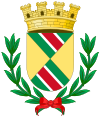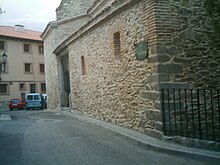Miraflores de la Sierra
| Miraflores de la Sierra municipality | ||
|---|---|---|
| coat of arms | Map of Spain | |

|
|
|
| Basic data | ||
| Autonomous Community : | Madrid | |
| Comarca : | Cuenca Alta del Manzanares | |
| Coordinates | 40 ° 48 ′ N , 3 ° 46 ′ W | |
| Height : | 1147 msnm | |
| Area : | 56.56 km² | |
| Residents : | 6,108 (Jan 1, 2019) | |
| Population density : | 107.99 inhabitants / km² | |
| Postal code : | E-28792 | |
| Municipality number ( INE ): | 28085 | |
| administration | ||
| Mayor : | Juan Manuel Frutos ( PSOE ) | |
| Address of the municipal administration: | Aymto de Miraflores de la Sierra Pza España 1 Miraflores |
|
| Website : | www.mirafloresdelasierra.net | |
| Location of the municipality | ||

|
||
Miraflores de la Sierra is a city in the north of the Community of Madrid . It is located 49 km north of Madrid in a valley that is bordered by the Sierra de Guadarrama mountain ranges . The country roads to the Puerto de Canencia and La Morcuera mountain passes begin in the village . 6108 inhabitants live here (as of January 1, 2019). This number increases sharply in the summer months.
geography
Geographical location
The western part of the Castilian Divide Mountains (also: Iberian Divisional Mountains, Central Cordillera or Central System ) is the Sierra de Guadarrama, which separates the Autonomous Community of Madrid from the Autonomous Community of Castile-León . Miraflores is located on the plateau that slopes south-east from here. The Arroyo del Valle flows east of the municipality in a north-south direction, which flows into the dammed Río Guadalix at Guadalix . To the west, the municipality borders on the Parque Regional de la Cuenca Alta del Manzanares , the largest natural park in the autonomous community of Madrid.
Neighboring communities
The neighboring municipalities starting in the north in a clockwise direction are Canencia , Bustarviejo in the northeast, Guadalix de la Sierra in the southeast, Colmenar Viejo in the south, Soto del Real in the west and Rascafría in the northwest.
climate
Miraflores de la Sierra is characterized by an oceanic-continental climate with cold winters with regular snowfalls and hot summers. Skiing is possible in winter. From the capital Madrid you can still see the snow-capped peaks of the Sierra de Guadarrama in spring when the temperatures are already summery.
- See also: Madrid: Climate
history
origin of the name
Miraflores de la Sierra was founded by settlers from Segovia towards the middle or end of the 13th century . The first name of Miraflores was Porquerizas . This name could come from two different meanings:
- Place where pigs are bred and herded
- Place where wild boars are abundant
Both of these explanations fit perfectly to name this beginning medieval hamlet.
According to a legend, the name was changed in 1627 when Isabella von Bourbon , wife of Philip IV, stopped on a plateau at the foot of La Najarra on a trip to the Carthusian monastery of Paular . She looked at Porquerizas in the distance and she noticed the abundance of flowers and in the exuberance of her youth she cried: “mira, ¡flores!” ('Look here, the flowers!'). One of her companions suggested changing the name of the picturesque place.
middle Ages
The exact date of foundation is unknown. Diego Colmenares confirmed that in 1287 there were already two villages in the area of the Real de Manzanares. It is believed today that Porquerizas was founded under the reign of Alfonso X of Castile between 1252 and 1284. It is believed that the monarch placed this area under his protection around 1268 and gave it the name Real de Manzanares . He allowed repopulation of the communities regardless of who owned the lands before. This is how the communities of Guadalix de la Sierra , Porquerizas, Colmenar Viejo and / or Manzanares el Real came into being .
In the past, the entire royal area of today's natural park and the municipalities mentioned was called Real de Manzanares , from which, among other things, today's municipality of Manzanares el Real emerged . Real (i.e. royal) indicates the direct control of the king.
In 1363 King John I gave this area to Don Pedro González de Mendoza , the ancestor of the Counts of Real Manzanares, the Marquis of Santillana and the Dukes of El Infantado .
Modern times
In 1501 Porquerizas and other hamlets of the Real brought the demarcation of their territories to an end with the authority of the Reyes Católicos, which led to problems between Porquerizas and Guadalix de la Sierra and between Chozas (today: Soto del Real ) and Bustarviejo.
In 1523 Charles I of Spain ( Emperor Charles V of the Holy Roman Empire ) granted Miraflores city rights. Thus the legal dependence on Manzanares ceased. It still belonged to the rule of the Counts of Infantado.
Modern (19th and 20th centuries)
At the beginning of the 19th century the city administration supported the national defense council against the Napoleonic troops. Miraflores de la Sierra hosted many games of the guerrilla Abril, who had various skirmishes with the French during the Spanish War of Independence in 1812 .
The place has been known as a local recreation area since the end of the 19th century and its surroundings also attract many day-trippers who explore the hiking trails of the Canencia and Morcuera mountain passes from here.

population
Population development
In just 15 years from 1991 to 2006, Miraflores' population doubled. In 1991 there were 2,636 Miraflorens living in the community, in 1996 there were 3,365, 2001: 3,928, 2004: 4,741 and 2006 already 5,344.
| 1991 | 1996 | 2001 | 2004 | 2006 | |
|---|---|---|---|---|---|
| Population development | 2,636 | 3,365 | 3,928 | 4,741 | 5,344 |
Religions
As part of rural, less industrialized Spain, Miraflores belongs to España Negra , deeply Catholic Spain with an even higher proportion of Catholics than in the urban centers of Spain.
- See also: Religion and belief in Spain
politics
Municipal council
In the 2007 municipal council elections, the Partido Popular (Conservatives) received 1,510 votes (54.47%) and 7 councilors (Concejales), the PSOE (Social Democrats) 813 votes (29.33%) and 4 councils and the IU -CM ( Left) 397 votes (14.32%) thus 2 municipal councils. Thus, compared to the 2003 election, the PP replaced the PSOE as the strongest party. The number of councilors rose from 11 to 13.
| Municipal elections | 1987 | 1991 | 1995 | 1999 | 2001 | 2007 |
|---|---|---|---|---|---|---|
| Izquierda Unida | 0 | 0 | 0 | 0 | 0 | 2 |
| Partido Popular | 1 | 8th | 7th | 5 | 5 | 7th |
| PSOE | 4th | 3 | 4th | 6th | 6th | 4th |
| other | 6th | 0 | 0 | 0 | 0 | 0 |
| total | 11 | 11 | 11 | 11 | 11 | 13 |
Mayor of Miraflores de la Sierra is Pablo Altozano Soler.
Culture and sights
Attractions
- Church in the old town
- Fuente Nueva ( New Fountain ) on Calle Mayor, was built in 1791 on the site of a Fuente Vieja . In the past it was also used as a horse trough for travelers and as a public washing area for the population.
- La Vieja Estación ( old train station ) on the Madrid- Irún railway line . The station now serves as a restaurant.
- Plaza de Toros ( bullring ).
- El Álamo ( The Old Elm ). A time-honored elm from the 18th century that perished in 1989/1990. The 1977 Spanish Nobel Prize for Literature, Vicente Aleixandre , who had spent his summers in Miraflores since 1925, dedicated a poem to this tree.
Natural park
See: Biosphere Reserve Cuenca Alta del Río Manzanares (Spanish: Reserva de la Biosfera de la Cuenca Alta del Río Manzanares)
City festivals
- February 3rd: San Blas
- May 15th: San Isidoro
- August 15th: Celebrations in honor of the local patroness, the Blessed Virgin de la Asunción ( Sante Maria Asunta )
Economy and Infrastructure
traffic
- Miraflores can be reached from Madrid on the Colmenar Viejo M-607 (separate direction) road.
- Miraflores can be reached via Guadalix on the Madrid-Burgos A-1 motorway.
- A bus line connects Miraflores with Colmenar Viejo, where the Cercanías de Madrid train station is located. The bus line also goes to Madrid.
sons and daughters of the town
- Gerardo Vera , costume designer, actor, film and theater director
Web links
- Elections in the Community of Madrid. Local elections . Spanish. Entry page to the results from 1987 to the present day.
- Miraflores de la Sierra on the Spanish language Wikipedia
- Miraflores de la Sierra on the lusophone Wikipedia
Individual evidence
- ↑ Cifras oficiales de población resultantes de la revisión del Padrón municipal a 1 de enero . Population statistics from the Instituto Nacional de Estadística (population update).
- ↑ Figures based on the Spanish version of Miraflores de la Sierra , except 2004 value from the Portuguese
- ↑ Local elections. Municipal councils by municipality and party affiliation 2003. (PDF; 10 kB) Statistical Institute of Madrid (Spanish)
- ^ Elecciones Locales . Instituto Estatística de Madrid: Elecciones en la Comunidad de Madrid [Results of the local elections 1987-2007] (Spanish)
- ↑ El PP de Madrid aprueba los candidatos a la alcaldía de cuarenta y tres municipios . PP Madrid, press release, November 29, 2006 6:00 pm
- ↑ Article on the Church. ( Page no longer available , search in web archives ) Info: The link was automatically marked as defective. Please check the link according to the instructions and then remove this notice. City Administration Page (Spanish)







